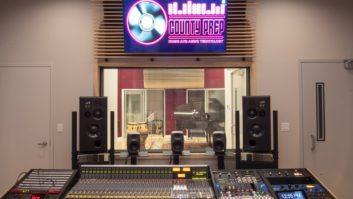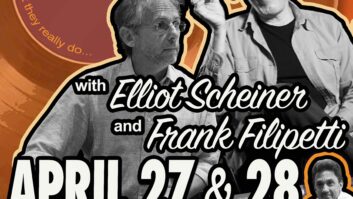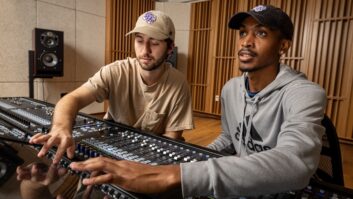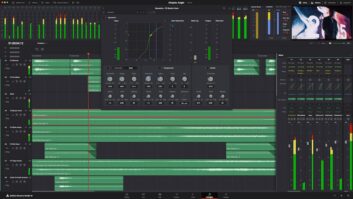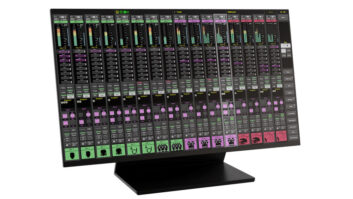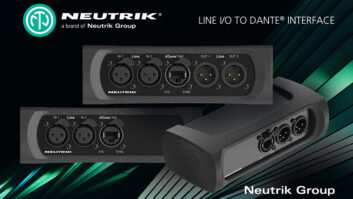There’s a nationally recognized robotics department, with associated old-style and new-style machine rooms and electronics stations. There’s a high-def television station that rivals a network suite, and has been used by Fox Sports in the past. There’s an all-new Innovation wing, based around “The Maker’s Space” and 37 3D printers. An upcoming submersible control system. A full orchestra plays before a stage-long LED screen in the performance hall. There’s a high-def television station that’s been used by Fox Sports when they needed space. And now there’s a world-class recording studio, modeled after the control room in the famous Power Station Studio A and featuring an API Vision console.

Rock and Roll Academy students come together at lunch to jam in the multipurpose studio space. Note the JBL playback on the walls, and seating for roughly 200 people.
And this is all part of a public high school in New Jersey! Not a magnet school, not a charter school. Simply Mount Olive High School, home of the Marauders.
By nearly all accounts, Dr. Larrie Reynolds, superintendent of schools, has been the driving force in the growth at Mount Olive High School. He arrived 10 years ago after leaving a company he founded that provided afterschool programming and services nationwide for grades K-12. He rides a motorcycle, plays keyboards in two rock bands, and would be a contender in any national competition for Coolest Superintendent.
In 2006 Reynolds sold his company and relocated from Dallas to New Jersey. He could have retired, but he believes earnestly in developing young minds for a better future, and he believes firmly that academia must adapt to modern life.
“The future is becoming dedicated to the cultivation of science,” he says. “Typically we think of science as biology and chemistry and such. But the science of the future is of a different type. There’s robotics, the idea of flying drones, underwater submersibles, and working with sounds and lights. Not too many schools even do this. That’s why we invested in the LED screen for our stage, and it’s why we invested in the finest sound recording equipment. We want students to be ready for whatever they want to do when they leave high school.

Stephen Thompson, Rock and Roll Academy Teacher, with senior Charles Jandura.
“The idea of artistic expression is really promoted by the technical expertise of the professionals who produce it,” he continues. “I’ve had the opportunity to play music in various venues. Whether or not I have a good night depends on the sound. If I don’t get the right mix in my monitors, it changes how I perform. Even though music is considered an art, there’s a lot of science to it. A lot of that comes in behind the scenes, where an engineer can make it sound terrific, through effects and balance and clarity. It’s both an art and a science.”
A couple years ago, with the robotics department in place and humming along, Reynolds and Mount Olive High School Principal Kevin Stansberry looked at a large performance space at one end of the school that had lain dormant for the past decade or so. It had a relatively large footprint, with a height of roughly 50 feet. Split into two floors, it would come to house The Maker Space, or Marauder Innovation Learning Lab, with the 3D printers on the top floor, and a recording studio control room and multipurpose space (it would serve as both a studio and host the wrestling team) on the bottom.
Anthony Gianforcaro of Gianforcaro Architects, Engineers & Planners was the architect of record for the project and had drawn up plans to split the space in two. “The first challenge was to design the new floor above without having columns in the middle of the room below,” he says. “The span was quite large and therefore we had to use substantial-size steel to support the new concrete floor above. The other challenge was to design the performance area to withstand wrestling. We used a real wood floor and brick half walls to surround the area.”

Brian Carlstrom, left, a junior, and senior Azalia Whitlock
“We used cloth seats, carpeting in the seating areas, and acoustical panels on the walls in the seating area to dampen the sound,” he adds. “The fireproofing on the steel above was left exposed, which also helped slightly to dampen the sound in the performance area. The geometry of the room was someone set by the space we had to work with. We were able to create a ‘theater in the round’-type area for the performers.”
But he had never built a professional recording studio. In October 2015, through friends of friends at a local church, where Reynolds led the choir and played in the band, producer/engineer Ron Saint Germain’s name was offered up as a local guy who knew a thing or two about recording studios. He was brought in to consult, less than two months before the project would go out to bid, meeting the team for the first time around a conference table. He looked at the plans and noticed problems right away. He also noticed that they would be entirely in-the-box, no console. Then they took him to the raw, empty space.
“The live room was going to be what the live room was going to be,” Saint Germain explains. “The studio itself is totally workable. The seating in the U shape allows you to host some 200 people comfortably, and you still have a huge performance space. And once I saw the space where the control room would be, I immediately thought of Power Station Studio A. The footprint was perfect, and we could drop it right in. The only real modification we ended up making was that we put the two iso booths off the control room, as the studio space was fixed.”

Senior David Palacios on guitar
So Saint Germain approached the founder of the world-famous Power Station Studios (now named Avatar), Tony Bongiovi, whom he had known for some 40 years, and asked if he would like to sell his plans and be involved. He did.
“I was in disbelief when I first walked into the building,” Bongiovi recalls. “This is a high school! With video production, robotics and a real sophisticated design approach. Larrie wanted the same thing for audio, and we brought him the control room that has hosted more hits than any other facility in the world.”
Saint Germain and Bongiovi brought the architects to New York and walked through Avatar to give them an idea of the design tolerances and specifics. After a lot of back and forth, they built it, on isolation springs, wall-withinwall construction, and doors that open in, rather than out—the little things that make a difference.
“It’s a smaller control room on purpose,” Bongiovi says. “We originally built it in 1977 to handle the SPL of a 15-inch speaker, with a .25-second decay time. We put in the slotted absorbers to deal with low frequencies, and we made the acoustics work while maintaining a perceived symmetry when you’re in the room. I still can’t believe that Power Station A is now in a high school.”
“The control room is completely isolated from the surrounding spaces,” adds Gianforcaro.” The entire room is on a ‘rubber’ pad and no walls are attached to the surrounding structure. The HVAC equipment is dedicated to that space and all equipment is on isolation springs. The electrical grounding is also isolated from the building. The Maker Space is on a concrete slab, which gives us mass between the spaces.”
While the room was being built, Saint Germain began putting together the equipment package, albeit with a budget that was cut considerably. He took Trevor Campbell, audio engineering teacher, around to look at SSL, Neve and a few others, then opted for a 32-frame API Vision.

Junior Gabriel Vasquez on the drums
“I wanted the students to be able to get sound quickly,” Saint Germain says. “A microphone, preamp, fader, and you’re recording, without being dependent on computers. The Vision has a very small footprint. We were originally going for 48 faders. But there was a 32-frame that had already been built. We reconfigured it in the frame and budget. They now have essentially 48 channels of audio in a school that had been recording with stereo mics. They have a console that can do 5.1, 7.1 and stereo simultaneously. And they need that. Trevor has put students on the console immediately and got sound with a microphone. They’re so happy to get sound up.” Saint Germain also selected Modern Audio Design Mad-Max near-field monitors, a personal favorite. Recording is to Pro Tools.
The new studio debuted with the start of the 2016-17 school year, as part of the introduction of the Rock and Roll Academy, a program not unlike the fictional School of Rock.
“We used to think of rock and roll as being unscholarly,” Reynolds says. “You’re supposed to study the classics. But this is 2016 and rock and roll is the classics. Lennon and McCartney can be every bit as important as Beethoven and Mozart. Beyond the scholarship, there is just the fun factor of doing something that you do well. We’re finding that kids are coming in to school who might not have cared, but the reason they put forth the greater effort overall is that they can’t wait to be in the Rock and Roll Academy. It’s a life changer.
“The kids we see in Rock and Roll Academy classes are not the kids you think you’ll see. The invisible kid. He’s up on stage now and rocking out. It’s sort of the real-life School of Rock. The kids aren’t necessarily the cool kids, but they’re redefining what cool is.”


